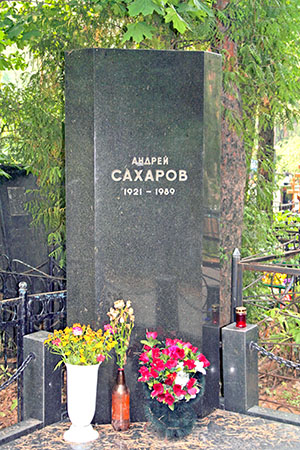Andrei Sakharov
 Grave of Andrei Sakharov in the Vostryakovo Cemetery (Востряковское кладбище) n Moscow. Photo credit.
Grave of Andrei Sakharov in the Vostryakovo Cemetery (Востряковское кладбище) n Moscow. Photo credit.
Андрей Дмитриевич Сахаров (Andrei Sakharov, 1921-1989) was an outstanding nuclear physicist, pre-eminent Russian dissident and outspoken human rights activist. In 1975, he was awarded the Nobel Peace Prize for his activism, but he was not allowed to attend the ceremony. His wife, Elena Bonner (Елена Георгиевна Боннэр, 1923-2011), read his Nobel lecture in Sakharov's absence.
As a physicist, Sakharov worked on the development of thermo-nuclear weapons in the 1950s. He also later did research on important aspects of nuclear fission and fusion. By about 1960, Sakharov became concerned with the ethical implications of his work on weapons of mass destruction, and he actively opposed nuclear proliferation and atmospheric testing.
In the 1960s, a wave of intellectuals began to openly critique the Soviet regime. The key moment for these dissenters came in 1966. In February of that year, a "show trial" was staged in Moscow. Iulii Daniel (Юлий Мáркович Даниэль, 1925-88) and Andrei Sinyavskii (Андрей Донатович Синявский, 1925-97) were convicted of anti-Soviet agitation and propaganda for publishing satirical writings outside of the Soviet Union. The verdict of guilty indicated that the "Thaw" was over and that the Soviet regime was not going to tolerate much open speech or criticism. Daniel and Sinyavskii had been charged under the famous Article 58:10, "propaganda and agitation that called to overturn or undermining of the Soviet regime." (Wikipedia) Here is some more from the article:
- propaganda or agitation with the purpose of undermining or weakening of the Soviet power or with the purpose of committing or incitement to commit particularly grave crimes against the Soviet state (as defined in the law);
- the spreading with the same purposes of slanderous fabrications that target the Soviet political and social system;
- production, dissemination or storage, for the same purposes, of literature with anti-Soviet content
The trial really was the start of an active, dissident movement amongst Soviet intellectuals. Much of the work was carried out underground by virtue of samizdat (self-published) writings that were circulated had-to-hand or in underground journals like the Chronicle of Current Events (Хроника текущих событий, 1968-83). Some items, such as Aleksandr Solzhenitsyn's The Gulag Archipelago, were smuggled out of the country and published.
Sakharov became a more active participant in the dissident movement. He had already begun to voice concerns about nuclear weapons, and now he became an advocate for human rights. In 1970 he was one of the founders of the Committee on Human Rights in the USSR, and in 1975 he was awarded the Nobel Peace Prize. His lecture, "Peace, progress, human rights" noted how the three were "insolubly linked to one another" and followed up on the themes that he had expressed in his 1968 work "Progress, Peaceful Coexistence, and Intellectual Freedom."
Regime pressure on Sakharov grew through the 1970s, and by the 1980s he was kept under police surveillance and exiled. Gorbachev allowed Sakharov and his wife to return to Moscow in 1986 and resume political activity. Andrei Sakharov died in 1989.
It is difficult to say exactly what Sakharov and the other dissidents achieved in the Soviet Union. They were all harassed, many left, some were silenced, but they were all courageous. To the world they presented an image of fighters for free speech in a repugnant and evil regime, but within Russia it is not clear how much of a larger impact that they had. One is reminded of the nineteenth-century Russian radicals who challenged the tsarist regime but who went generally unnoticed by the vast peasant population of the country. The world, and Russia especially, are still struggling to implement the three theme focus of Sakharov's Nobel Prize lecture, "peace, progress, human rights," and it is still a very real struggle.
![]()
Some suggested resources:
Wikipedia (See the Russian entry.); the New World Encyclopedia entry is not that much different. Wikimedia Commons has a few images devoted to Sakharov.
Мир, прогресс, права человека (Sakharov's Nobel Peace Prize lecture); translated as Peace, Progress, Human Rights; here is the Nobel Peace Prize citation.
Andrei Sakharov, Progress, Coexistence, and Intellectual Freedom (1968)
Andrei Sakharov, Moscow and Beyond (1992)
Alexander Solzhenitsyn, "Peace and violence – Sakharov for the Nobel Peace Prize" Index on Censorship, 2 (1973): 47–51.
Anatoly Shcharansky, "The legacy of Andrei Sakharov". Journal of Democracy, 1 (1990): 35–40.
Zhores Medvedev, "The legacy of Andrei Sakharov". Index on Censorship, 19 (1990): 13–14.
Andrei Sakharov: Photo-chronology
Andrei Sakharov Archives at Harvard University includes the papers of several other dissidents, including Elena Bonner (his wife), Andrei Amalrik, Vasilii Grossman.
Архив Сахарова (Sakharov Archives, in English)
PBS: Think Tank: Unexpected Dissident: Andrei Sakharov
Masha Gessen, Fifty Years Later, Andrei Sakharov’s Seminal Essay Is a Powerful Model of Writing for Social Change (The New Yorker, 25 July 2018)
Raymond H. Anderson, Andrei Sakharov, 68, Nuclear Inventor and Mainspring of the Soviet Conscience (New York Times, obituary, 15 December 1989)
There are a lot of obituaries and other articles about Sakharov available on the web. For extra credit please suggest to your instructor a relevant website for this unit of the course. Send the title of the site, the URL and a brief explanation why you find the information interesting and applicable to the material being studied in this unit.